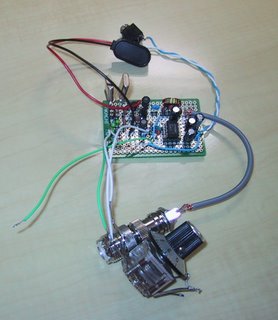Monday, November 27, 2006
Radiating Feeder: Applying a Theory by Vadim Demidov
I've found the interesting article of the antenna for MicroVert. It describes the antenna radiation and should be read.
Friday, November 24, 2006
Wednesday, November 08, 2006
W1AW Receiver
The simple receiver circuit has been found in New England QRP club. It is W1AW Receiver. The mixer is SA602 and audio amplifier is LM386. The original circuit is for 80M band. You can build it easily.
Schemantics of W1AW Receiver
Sunday, November 05, 2006
pixie2 board made by myself
 Here is the board that I put the pattern using EZ-Pen. You can easily write your original pattern. It is the pixie2 circuit that I built this weekend.
Here is the board that I put the pattern using EZ-Pen. You can easily write your original pattern. It is the pixie2 circuit that I built this weekend. This is the broad that I put the parts of pixie2. This is the modification for super-VXO with varicon. You can receiver the signal between 6997-7023KHz.
This is the broad that I put the parts of pixie2. This is the modification for super-VXO with varicon. You can receiver the signal between 6997-7023KHz.When the 9V battery is used, the output power is about 150mW with MPS2222A.
Zero Beat again
I'd like to consdier the zero beat on the direct conversion receiver again.
Suppose that the CW singal is received on 7010KHz. The local oscillator generates 7009KHz. The difference between the received signal and the local sinigal is 1KHz and you can hear it at audio frequency at 1KHz.
The frequency of the local oscillator is increasing to 7010KHz and the difference is getting smaller. The audio frequency is getting lower. When the received signal and the local oscillator is the same, there is no audio singal that is Zero Beat.
At each side of zero beat, you can hear the audio signal as 1KHz. In this example, you can hear 1KHz audio signals on either 7009KHz or 7010KHz. The receiving characterisitics called "double-sideband effect". It means that you can hear the audio tone for both side of the frequency.
This characteristic can be used to advantage. It gives you a choice of 'two spots' that you can choose for the reception of a CW signal - you can tune your oscillator to above or below the incoming signal and still get a suitable tone for reception of the wanted signal. One spot may have an interference advantage over the other by changing the pitch of an adjacent and unwanted signal whilst keeping the pitch of the wanted signal the same.
If the transmitter frequency is negatively offset (TX frequency is 600-700 Hz below the RX frequency), one needs to tune on the “high side” of zero beat in order to have the transmit frequency fall within the other station's receiver pass band.
Suppose that the CW singal is received on 7010KHz. The local oscillator generates 7009KHz. The difference between the received signal and the local sinigal is 1KHz and you can hear it at audio frequency at 1KHz.
The frequency of the local oscillator is increasing to 7010KHz and the difference is getting smaller. The audio frequency is getting lower. When the received signal and the local oscillator is the same, there is no audio singal that is Zero Beat.
At each side of zero beat, you can hear the audio signal as 1KHz. In this example, you can hear 1KHz audio signals on either 7009KHz or 7010KHz. The receiving characterisitics called "double-sideband effect". It means that you can hear the audio tone for both side of the frequency.
This characteristic can be used to advantage. It gives you a choice of 'two spots' that you can choose for the reception of a CW signal - you can tune your oscillator to above or below the incoming signal and still get a suitable tone for reception of the wanted signal. One spot may have an interference advantage over the other by changing the pitch of an adjacent and unwanted signal whilst keeping the pitch of the wanted signal the same.
If the transmitter frequency is negatively offset (TX frequency is 600-700 Hz below the RX frequency), one needs to tune on the “high side” of zero beat in order to have the transmit frequency fall within the other station's receiver pass band.
Saturday, November 04, 2006
EZ Pen for circuit

I've got the interesting product for homebrew. It's EZ-Pen (called E jis Pen in Japanese) by Namics. You can write the cicuit pattern on the board using the pen.
The instruction describes that you need to put the board in the hot plate, but I could use the hair dryer instead.
When you would like to build the circuit on the board with the easier way, you may check the product.


Friday, November 03, 2006
Wednesday, November 01, 2006
QRP Transceiver for less than $10
AL7FS writes the article of Pixie2 on Web. The tranceiver is under $10.
Subscribe to:
Comments (Atom)
